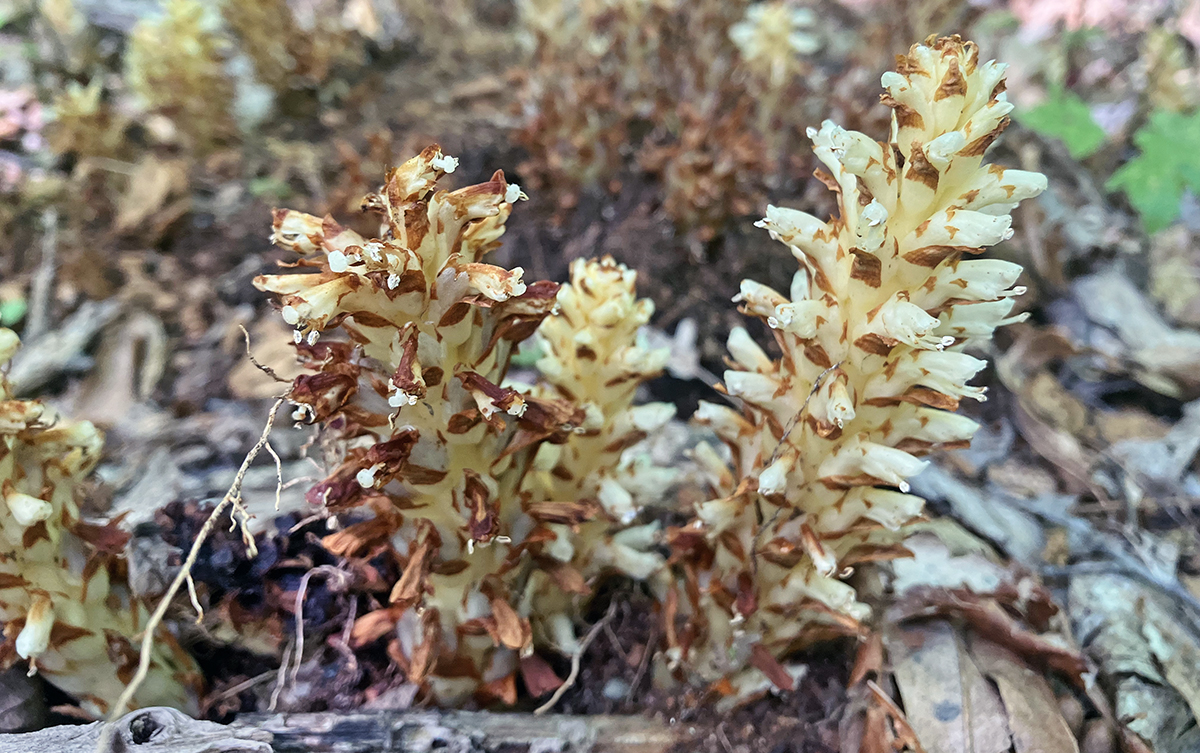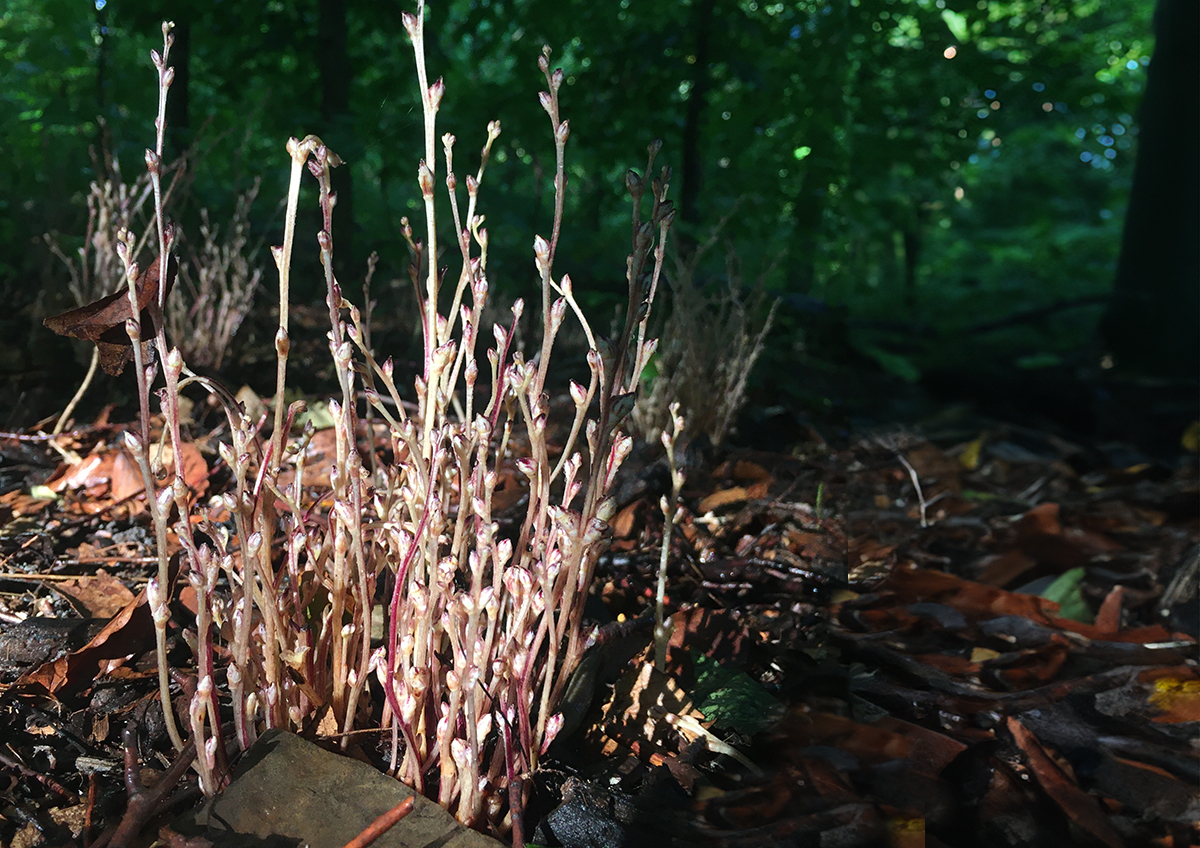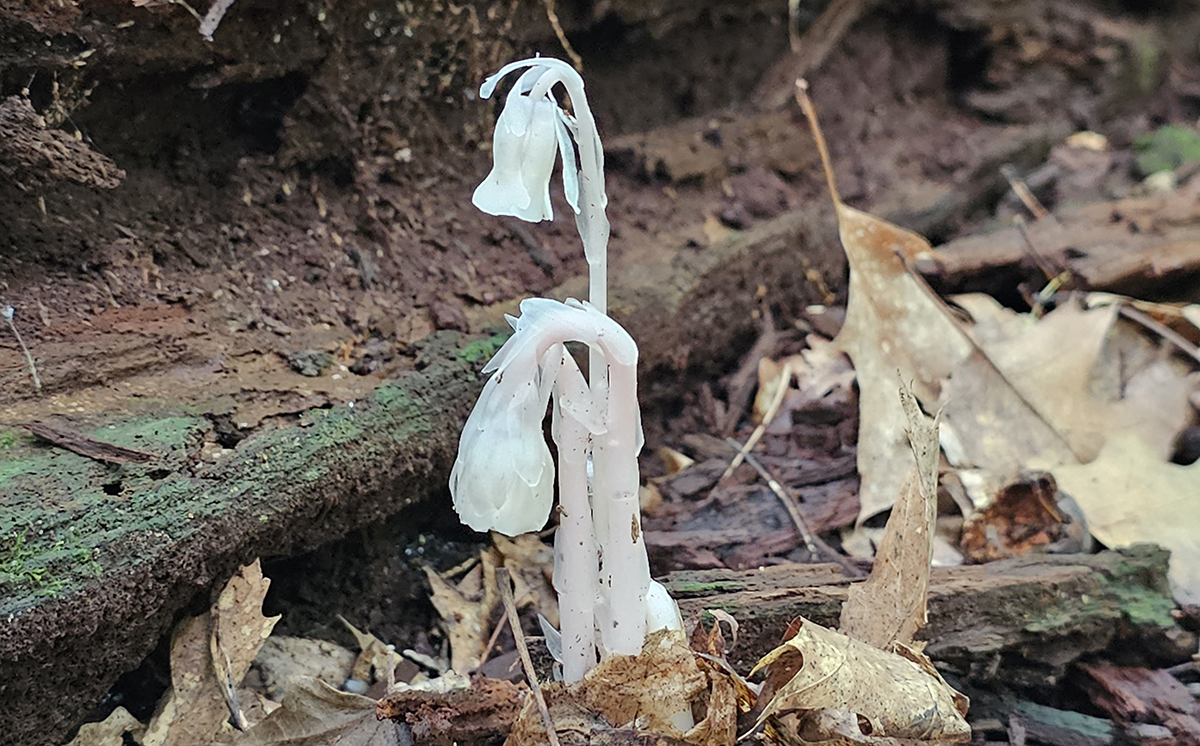LYDIA RADCLIFFE
Blendon Woods Naturalist
Have you ever been hiking in the woods and noticed something that reminds you of a fungus but looks an awful lot like a plant? After all, plants are green, right? Maybe not! Turns out even photosynthesis in plants is another rule for which there are exceptions. The fungus-resembling organism growing like a plant may very well have been a parasitic plant.
Parasitic plants lack the chlorophyll responsible for the green color present in most plants and necessary for photosynthesis. Rather than getting their nutrients from photosynthesis, they obtain it from other plants around them. Such plants are considered parasites because they take nutrients from other plants without offering the plants anything in return, and losing nutrients —while not necessarily devastating to a healthy host— still has a marginally negative effect on the host plant. Parasitic plants offer unique examples of strategic plant associations in forest ecosystems. Let’s take a closer look at a few types of parasitic plants you might find in Ohio’s forests — even at a Metro Park near you!
American cancer root

First up is a pine-cone shaped plant that is just wrapping up its blooming period this time of year. American cancer root (Conopholis americana) has a fleshy, cone-like stalk with reduced leaves that look like small brown scales. Its genus name refers to its resemblance to a pinecone (‘conos’=cone, ‘pholis’=scale in ancient Greek). When blooming in May and June, its flowers are small and yellowish with a dainty hood and lip. Cancer root prefers shady woods where its primary host plants, oak trees, are abundant. The cancer root attaches itself to an oak tree by first forming a large tuber underground that makes up most of the plant body, then penetrating the oak’s root tissue using specialized roots called haustoria. The haustoria allow the cancer root to absorb water and nutrients from the oak roots. The above-ground cone-like stalks only emerge after the initial tuber has formed, a process that takes about four years. A perennial, American cancer root lives for an average of nine to ten years; thus you can be pretty certain to find it around the same oak trees where you’ve observed it previously. Little to no scientific evidence points to this plant having cancer causing or prevention properties; its common name probably developed because of its parasitic nature. Other common names currently in use include bearcorn and oakdrops.
Beechdrops

Next up is another parasitic specialist that associates with a prominent canopy tree in our Ohio forests: beechdrops (Epifagus virginiana). As their name implies, beechdrops are found under beech trees; indeed, its genus name literally means “upon beech,” pointing to the parasitic association to the roots of these trees. The copper-colored to yellowish stalks of this plant germinate after being triggered by chemicals released from the beech tree into the soil. Like cancer root, beechdrops use haustoria to siphon off nutrients from beech tree roots. Although this plant is an annual, the dead striped stems can persist through the winter. The plant’s tiny flowers appear from August till October.
Ghost pipe

Our third example of a parasitic plant you might happily encounter in a nearby woodland comes to us from the blueberry family of plants (Ericaceae). Aptly named, ghost pipe (Monotripa uniflora) is white, translucent, and pipe shaped, with its single flower drooping towards the ground from a distinctly curved stem. The bell-shaped blossom that appears from June to September turns black as it develops into a ripe fruit. Standing at only 4 to 10 inches, you have to pay attention to spy this beauty on the forest floor, growing in shaded areas with plentiful leaf litter beneath a variety of trees including beech, birch, musclewood and oaks. Ghost pipe signifies the complexity of ecological associations in a forest, taking advantage of the symbiotic relationship between a host plant and its mycorrhizal fungi. The host tree and its fungus have a mutually beneficial relationship in that the tree provides sugars to the fungus, and the fungus assists the plant in absorption of nutrients and water. Not caring that while two’s company, three’s a crowd, ghost pipe diverts nutrients made by the plant from the mycorrhizal fungi. The types of mycorrhizal fungi most commonly hijacked by ghost pipe include the genera Rusula, the brittlegills, and Lactarius, the common milkcaps.
As we ease into summer, keep your eyes open for these resourceful plants entering or finishing up their blooming periods in a woodland near you! Each one points to a larger picture of the countless interwoven relationships in a forest ecosystem. From the tall trees of the canopy to these uncolored beauties on the forest floor, every organism depends on a lifeline of connection to the rich diversity of life found in our woodlands.
References
Baird, W.V. & Riopel, J. L. (1986). Life History Studies of Conopholis americana (Orobanchaceae). The American Midland Naturalist, 116(1), 140–151. https://doi.org/10.2307/2425946
Bear-corn. (n.d.). Ohio Department of Natural Resources. https://ohiodnr.gov/discover-and-learn/plants-trees/flowering-plants/bear-corn
Fodi, A. (2022, March 9). Trees and their fungal partners. Wild Food UK. https://www.wildfooduk.com/articles/trees-and-their-fungal-partners-by-attila-fodi/
Foster, S. & Duke, J.A. (2014). Peterson field guide to medicinal plants and herbs of eastern and central North America (3rd ed.). Houghton Mifflin Harcourt Publishing Company.
Galloway, H. (2011, July 6). Squawroot. Mountain Lake Biological Station, University of Virginia. https://mlbs.virginia.edu/organism/conopholis_americana
Jaunzems, M. (n.d.). Plant of the Week: American cancer-root (Conopholis americana (L.) Wallr.). U.S. Forest Service, United States Department of Agriculture. https://www.fs.usda.gov/wildflowers/plant-of-the-week/conopholis_americana.shtml
Keesling, A. (2018. September 4). Indian pipes: The parasitic plants in bloom at the New York Botanical Garden. New York Botanical Garden. https://www.nybg.org/blogs/science-talk/2018/09/indian-pipes-the-parasitic-plants-in-bloom-at-the-new-york-botanical-garden/
Lobstein, M. (2020, December 16). A parasitic lifestyle: Beechdrops and their relatives. Virginia Native Plant Society. https://vnps.org/a-parasitic-lifestyle-beechdrops-and-their-relatives/
Smith, H. (2020, October 15). Beechdrops – A native parasitic plant. North Carolina State University Cooperative Extension. https://guilford.ces.ncsu.edu/2020/10/beechdrops-a-native-parasitic-plant/
Volk, T. (2002, October). Tom Volk’s Fungus of the Month for October 2002. Tom Volk Fungi. http://botit.botany.wisc.edu/toms_fungi/oct2002.html

Nice article about our native parasitic plants. They get very little publicity.
I saw Ghost Pipe for the first time at Blendon Woods. I will never forget it, I was so smazed! Thanks for the informative article. I will keep an eye out for Beechdrops next!